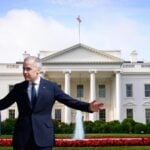President Donald Trump told a hastily convened gathering of generals and admirals in Quantico that the military should treat some American cities as “military training grounds,” a phrase that quickly drew fire from civil liberties advocates and raised questions about the scope of federal power on domestic soil.
The speech, delivered Tuesday to hundreds of senior officers, was unusual both for its venue and for its overtly political tone.
The president framed the idea as part of a broader push to combat what he called an “invasion from within,” language that echoes recent deployments and threats of deployments to large metropolitan areas.
He did not outline a timetable, a chain of command, or a legal mechanism for routine urban training inside active neighborhoods.
Without those specifics, the proposal lands in a thicket of constraints that have governed civil-military relations for generations.
Defense Secretary Pete Hegseth, speaking ahead of the president, pledged an end to what he called politically correct leadership and pressed for tighter fitness and discipline standards.
He also challenged dissenting senior officers to step aside. Together the remarks signal a sharp rhetorical shift toward domestic missions, even as the services continue to juggle commitments abroad.
Markets largely treated the spectacle as noise rather than a near-term catalyst.
Defense primes have been steady in recent sessions, reflecting healthy backlogs and a stable budget track rather than sudden new revenue tied to urban operations.
Investors who follow the group know that training doctrines, procurement calendars, and contract vehicles change slowly, often over years and only after Congress appropriates money.
The muni market also showed little immediate reaction, but portfolio managers said any sustained federal presence inside city limits, even for training, could complicate local security plans and event logistics that feed into credit analysis.
Legal experts note that regular military participation in domestic policing remains constrained by the 1878 Posse Comitatus Act, which limits the use of federal troops in civilian law enforcement.
While the National Guard can operate under state authority, and the Insurrection Act provides narrow exceptions, the president’s formulation of ongoing “training grounds” in active urban settings would likely face court challenges and resistance from local officials.
Those hurdles matter to investors because contested mandates tend to move slowly, invite injunctions, and add headline risk without creating predictable revenue streams.
Urban training ranges typically require controlled environments built on federal land or in purpose-designed mock cities, not live neighborhoods where legal exposure and insurance costs multiply.
Even if doctrine evolves, procurement would move through established requirements processes, testing, and oversight before dollars flow at scale.
City budgets could feel indirect pressure if federal training ambitions spill into joint exercises that demand local coordination, overtime for police and transit, and broader security perimeters.
Tourism and convention traffic are sensitive to perceived instability, which is why mayors often push back against federal incursions that read as open-ended.
Insurers also pay attention, particularly where special event coverage, business interruption language, and liability for property damage intersect with federal activities.
None of that is a bullish setup for urban balance sheets if plans are imposed rather than negotiated.
Canada-based investors and suppliers should watch the same channels.
The U.S. and Canadian defense industrial bases are deeply integrated, and any change in doctrine that prioritizes urban training would ripple through cross-border supply chains for communications, sensors, and training systems.
That said, the gating factors remain legal authority and appropriations, not manufacturing capacity.




















